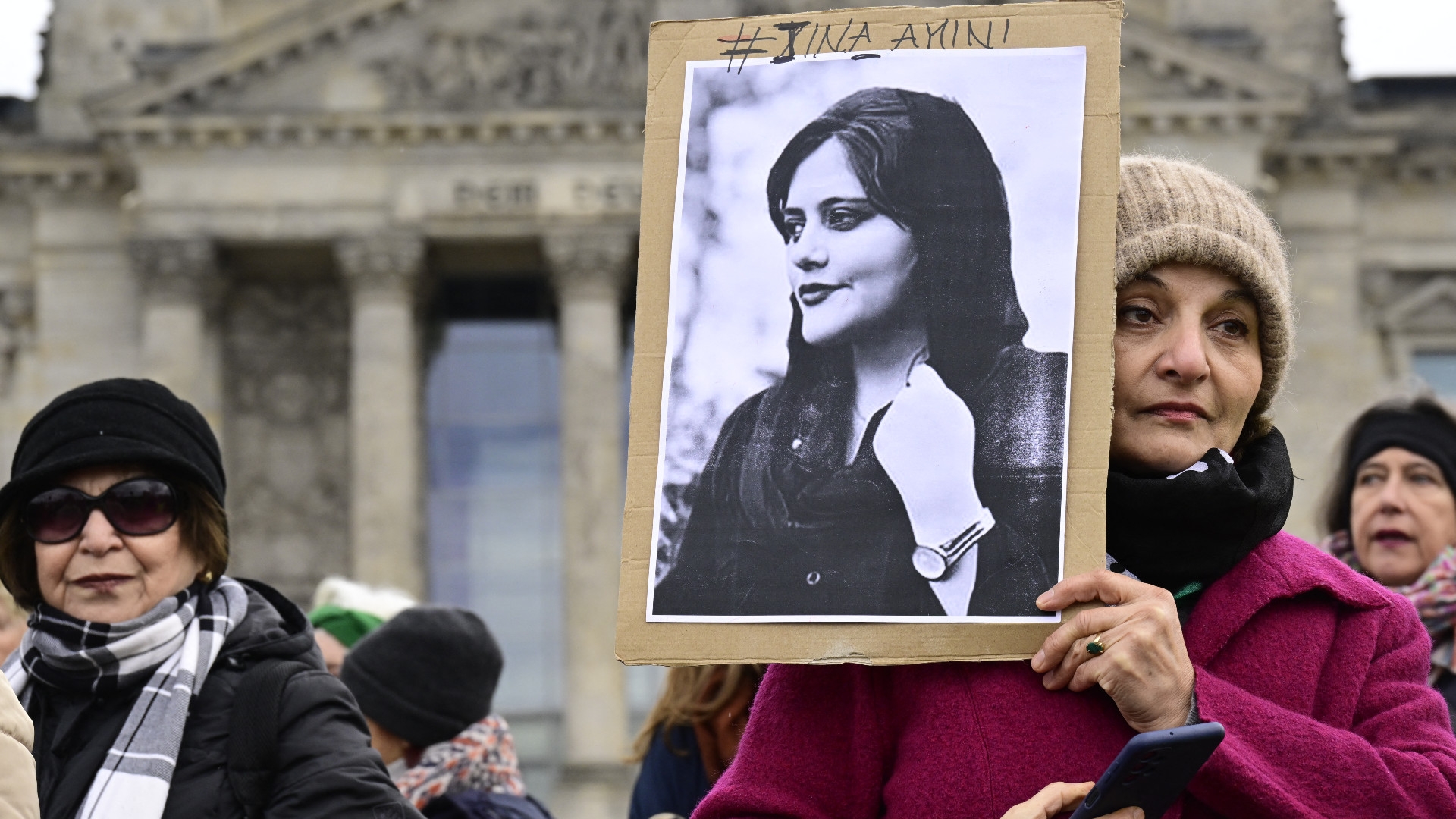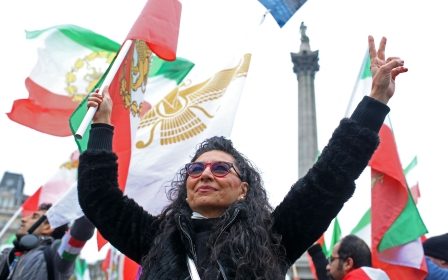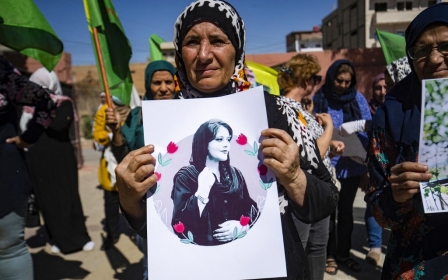Mahsa Amini Anniversary: Why Iran's 2022 protest movement failed

On 13 September 2022, 22-year-old Mahsa Amini was arrested in Tehran by the Guidance Patrol, the religious morality police of Iran's government, allegedly for violating hijab rules.
Tragically, she fell into a coma hours after her arrest and passed away three days later on 16 September under suspicious circumstances.
Her untimely death served as the catalyst for an agitated Iranian society, leading to widespread protests that erupted across the nation.
The tumultuous and chaotic upheaval marked the most significant unrest in Iran since the 1979 revolution. As the country approaches the one-year anniversary of Mahsa's death, Iranian authorities have consistently issued warnings about the possibility of a renewed wave of unrest.
New MEE newsletter: Jerusalem Dispatch
Sign up to get the latest insights and analysis on Israel-Palestine, alongside Turkey Unpacked and other MEE newsletters
For a significant faction of Iranian women, mainly those living in large cities, the battle over mandatory hijab goes back to the early post-revolution days - sometimes with more momentum, sometimes less.
But the sorrowful death of Mahsa Amini ignited a surge of public outrage, leading to the most notable upheaval in the history of post-revolution Iran. Young men, particularly those in major cities, rallied to the uprising, while women assumed an unparalleled role as the backbone of the movement.
This raises an important question: What made this case different from previous events?
Death of the reform movement
At the end of the second term of the moderate former president, Hassan Rouhani, the ultra-conservative Guardian Council, responsible for vetting candidates, eliminated all moderate and reformist contenders.
This was done ahead of the 2021 presidential election, which was won by Ebrahim Raisi, a fervent follower of the supreme leader, Ayatollah Ali Khamenei.
The emphasis on 'woman, life, freedom' lacked the capacity to elevate the movement to revolutionary proportions
This decision mirrored a comparable approach adopted during the 2019 parliamentary elections, where numerous reformist and moderate candidates were disqualified en masse. The two manoeuvers allowed the hard-liners to gain control over all three branches of the government for the first time since Khamenei assumed leadership in 1989.
So, it became increasingly evident that the hard-liners, who could not have taken this action without the approval of Iran's top leader, had decided to purge for good the reformists and moderates who had overseen the administration and maintained a substantial presence in parliament for the past three decades.
The 2021 presidential election witnessed the lowest voter turnout since the 1979 revolution, dropping from approximately 73 percent of eligible voters in the 2017 election, during which Rouhani secured re-election, to a mere 48.8 percent.
In Tehran, the historical stronghold of modernist factions who oppose the government, voter turnout plummeted from 70 percent in 2017 to 34 percent in 2021.
Hence, Raisi's election, a consequence of substantial manipulation in the candidate vetting process by the Guardian Council, signified the conclusion of the reform movement chapter in the history of the Islamic Republic of Iran. The movement had its origins in 1997 with the election of reformist president Mohammad Khatami.
Conservatives go rogue
A few months into the Raisi administration, the conservatives' triumph in securing control over all three branches of government bolstered their confidence, leading them to believe they could advance their agenda without opposition. As part of their efforts, they reactivated and deployed the morality police with a heavy hand.
These forces aggressively targeted women who did not adhere to the dress code, engaging with them brutally. Witnesses captured shocking footage of women being arrested for hijab violations, which then circulated widely on social networks.
By September 2022, the prospects of a successful nuclear deal between Iran and world powers appeared increasingly bleak. Negotiations had come to a standstill, with the Iranian currency, the rial, plummeting in value at an alarming rate.
Simultaneously, the nation was grappling with an unprecedented wave of inflation, setting new records. Official data indicated that the unemployment rate among individuals aged 18-35 stood at 16.3 percent, with a significant 41 percent of the total unemployed comprising young university graduates.
While 30 million people lived below the poverty line, according to government statistics, another 23 million fell from the middle class to a new category, the "poor middle class".
Corruption, mismanagement, and conflict with the United States that prolonged sanctions seemed endless.
This whole dark backdrop extinguished any glimmer of hope for a huge faction of society, mainly young urbanites. When Mahsa died, society was ready to explode. The activities of millions of Iranians, especially the youth, on social networks propelled the news to the forefront of global headlines. And yet, the demonstrations failed to bring political change.
It is thus worth re-examining that uprising to find out the likely reasons that a movement of such magnitude would fail to translate into a political transformation in Iran.
Shortcomings
The lack of effective leadership was the most cited reason for the protest movement's failure, with experts emphasising the need for a leadership that would not only be highly popular but also beyond the reach of the Iranian government.
Undoubtedly, the protests presented the most formidable and enduring challenge encountered by Iran's governing system. However, the absence of a central body to provide direction to the movement, sustain the protesters' hope for an alternative to the Islamic system, and organise the decentralised protests became increasingly problematic as the protests gained momentum and faced escalating government repression.
A six-member council was formed abroad to lead the movement, but differences gradually appeared among the members, and the group fell apart.
The violent crackdowns against protesters undeniably played a role in thwarting their efforts to overthrow the system. Nonetheless, there were additional, though less frequently discussed, factors that also contributed to the movement's inability to bring about political change.
While the protests initially began with the very progressive slogan of "woman, life, freedom," which strongly opposed the mandatory hijab, subversive and anti-dictatorship slogans, particularly targeting Khamenei, swiftly became prevalent within the movement.
However, both within Iran and during unprecedented massive gatherings of the Iranian diaspora, women's rights took a central role in the protests, to the extent that the opposition and foreign media referred to it as the "women's revolution".
While the issue of discrimination against women resonated with the younger generation, paradoxically, it hindered the formation of a revolution against the existing system as it did not address the primary concern of a substantial portion of society - the economic struggles of the working class - and livelihood-related issues were rarely heard or highlighted.
Consequently, while young people facilitated the rapid spread of the protests, they failed to penetrate deep into society and attract diverse generational and class layers to the struggle.
In essence, the emphasis on "woman, life, freedom" lacked the capacity to elevate the movement to revolutionary proportions. In the patriarchal sectors of Iranian society, particularly among the traditional and lower socioeconomic classes, a women's movement realistically could not mobilise to the extent of active participation in the struggle.
Liberal reluctance
Another factor that contributed to the non-formation of a comprehensive movement was the hesitation and reluctance of the liberal religious section of society to fully engage in the struggle. While they sympathised with the movement's goals, they were taken aback by certain provocative actions carried out by some protesters abroad.
The divide stemming from the confrontational relationship between the government and dissidents has deepened so much that suppressing the protests only fans the resentment of the oppressed
Instances of female protesters stripping naked to express their opposition to the Iranian government's restrictions on women, although a few, as well as videos depicting some young boys and girls engaging in public displays of affection, shocked and alienated a significant portion of Iranian society.
The government, meanwhile, capitalised on these actions to label the movement as "hedonistic" and "morally corrupt," further undermining its credibility.
Undoubtedly, a significant social revolution has unfolded within Iran. Presently, a significant faction of urbanite women and young girls continue to resist and contend with the compulsory hijab, a cornerstone of the system's ideology.
At the same time, the divide stemming from the confrontational relationship between the government and dissidents has deepened so much that suppressing the protests only fuels the resentment of the oppressed.
Like smouldering embers beneath the surface, this simmering anger awaits another moment when it can erupt.
The views expressed in this article belong to the author and do not necessarily reflect the editorial policy of Middle East Eye.
This article is available in French on Middle East Eye French edition.
Middle East Eye delivers independent and unrivalled coverage and analysis of the Middle East, North Africa and beyond. To learn more about republishing this content and the associated fees, please fill out this form. More about MEE can be found here.





